Om Kashkuli
Firouz-Abad, Firooz Abad, Firuzabad Kashkuli, Kaskuli My parents visited the town of Firouz-Abad in the Kashkuli area. This is where they met Mr Heidari, who took them out to see his sister, a renowned and skilled knotter in the area. At the time, she was working on a Kashkuli carpet...Read more
Showing all 9 results
-
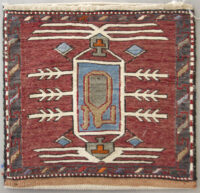
Kashkuli
bbm4638cm x 36cmkr. 2.400,- -
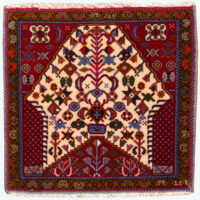
Kashkuli Tæppe
715440cm x 40cmkr. 1.900,- -
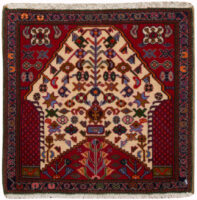
Kashkuli Tæppe
715540cm x 40cmkr. 1.900,- -
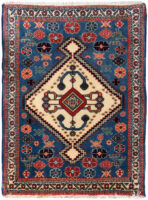
Kashkuli Tæppe
tg0500660cm x 43cmkr. 1.980,- -

Kashkuli Tæppe
tg04301146cm x 97cmkr. 11.900,- -
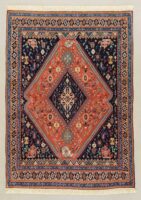
Kashkuli Tæppe
tt158160cm x 100cmTilbudSale! kr. 18.700,- (-15%) -

Kashkuli Tæppe
tg04997152cm x 110cmkr. 13.500,- -

Kashkuli Tæppe
tt00063154cm x 110cmTilbudSale! kr. 9.200,- (-20%) -
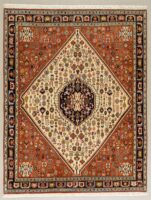
Kashkuli Tæppe
tt0127206cm x 159cmkr. 16.500,-
Showing all 9 results
Mere om Kashkuli
Firouz-Abad, Firooz Abad, Firuzabad Kashkuli, Kaskuli
My parents visited the town of Firouz-Abad in the Kashkuli area. This is where they met Mr Heidari, who took them out to see his sister, a renowned and skilled knotter in the area. At the time, she was working on a Kashkuli carpet that was going to be about 16 x 26 ft when complete. She was knotting using the Persian knot (the Senneh knot) on a horizontal loom, and she used no tools other than a small pocketknife to cut the yarn. The wool for the pile was very finely spun, and for the dyeing she used only natural dyes. It was a dense, good quality carpet. The knot density was just over 56,000 per ft2. She had also made a beautiful multi-coloured edge stitching, which was woven together with the carpet. The yarn was on both sides of the loom. The pattern was complicated, without many unicoloured surfaces, and instead it full of small stylised animals and flowers as well as a medallion. They could not see a pattern sheet next to the loom. So my mother asked, ‘Where do you keep the pattern?’ The woman responded, ‘This is our old family pattern. I can remember it, and then I knot whatever I feel in my heart.’ She was a skilled and very proud knotter. Recounting this visit, my mother has said how impressed she was and how it brought her joy and warmed her heart. Then, my parents went home with Mr Heidari to see more Kashkuli carpets. His daughter, a young girl 20-22 years of age, came in and greeted them rather shyly. She wanted to show them a carpet that she had just finished. The pattern also contained a stylised medallion and animal and flower motifs, and it was knotted at about 46,000 knots per ft2. She said that she was using a horizontal loom because the carpet is easier to beat evenly using this kind of loom, and this made it harder to end up with crooked borders. This is how we learnt that there were still people among younger generation who harboured great love for the carpet artistry. And even if Mr Heidari’s daughter, who was studying to be a doctor, was not going to live off it, it was nice to see that the young generation still honours the old traditions, still uses hand-spun wool from their own sheep and still carries out the dyeing themselves – using natural dyes.
Read more about Shiraz and Kashgai:
The town of Shiraz and the Kashgai area
Shiraz, Shiras
The town of Shiraz is the capital of the Fars province. It is one of the most beautiful cities in Iran. My family and I have visited many times. On the way to the city, you drive along an avenue lined with palm trees and endless rows of blooming roses. You can be quite intoxicated by the scent of the lemon trees, which bloom in May.
Shiraz is also called the ‘city of roses’ or the ‘city of poets’. This is where two of Persia’s famous poets were born, Saadi (1210-1291) and Hafis (1325-1389). Not many carpets are being made in the town of Shiraz, but it is a gathering point for the entire area. The carpets called Shiraz on the market today are knotted rather loosely, with 8,000-14,000 knots per ft2. The wool is often flexible and lustrous. The carpets can be extremely charming and fall in the lower end of the price range. However, the good quality products can be quite expensive. They are often called Kashgai carpets or Kashkuli. In this area, natural dyes are often used, but synthetic dyes are not unheard of. The patterns usually consist of hexagons and stylised animals and flower motifs. Typical to these nomadic carpets is that many of them have a two-coloured edge stitching. In some carpets from this area, you can often find motifs from Persepolis. They may consist of the characteristic columns, with the head of a horse or bull, or some of the motifs that are part of the wall decorations at the old palace. Persepolis was destroyed by Alexander the Great in 330 BC. A number of nomadic tribes still live in the area today. On the way south to Firouz-Abad, you can encounter nomads from the Turki tribes. They speak a Turkish dialect because they originate from Turkey, having migrated out of the country in the 13th-14th century.
These Turki nomads that we met were travelling all the way from Ghir, by the Persian Gulf, heading 300-350 km north to the Baktiar area. They did not want to settle down as they loved living a free life. They move their flocks of sheep north in April-May before it gets too hot, and then they head back south in October. The sheep are sheared twice a year, and the wool is hand-spun by the women into carpet yarn.
Kashgai, Gashkai, Qashqai, Gaschgai, Ghashgai, Kashkai
There are many nomadic tribes in the area. Most people just refer to them as Kashgai nomads, but behind this common name hides a wealth of individual tribes. For example, the Kashkuli, Bulli, Turki, Darashuri, Shisbuluki, Farsimadan, Safi Khani, Gallanzans, Rahimi and Qarachihi tribes are some of the most important in the area. The women from these tribes still knot beautiful carpets. You might think that they use Turkish knots because of their Turkish heritage. But this is not the case at all. In particular, the very tightly-knotted carpets are usually made using Persian knots (the Senneh knot).
Source:
You are reading an extract from the book ‘Oriental Carpets, Knottet with Love’ by Martin Munkholm.
This extensive book about all that is carpets can be borrowed in Danish libraries or be bought following this link: https://belle-rugs.dk/se-taepper/bog-aegte-taepper-knyttet-med-kaerlighed/
The book is published by Muusmann Forlag.
For more info: http://muusmann-forlag.dk/
You can find our selection of Kashkuli carpets underneath.
